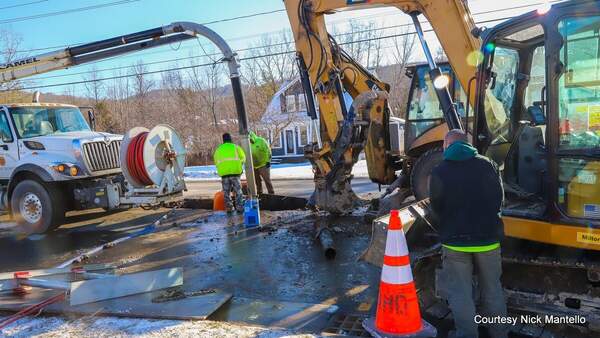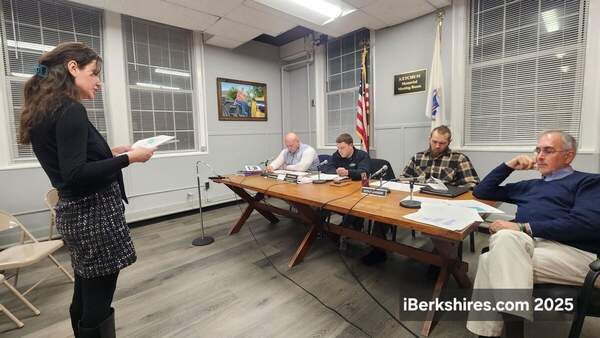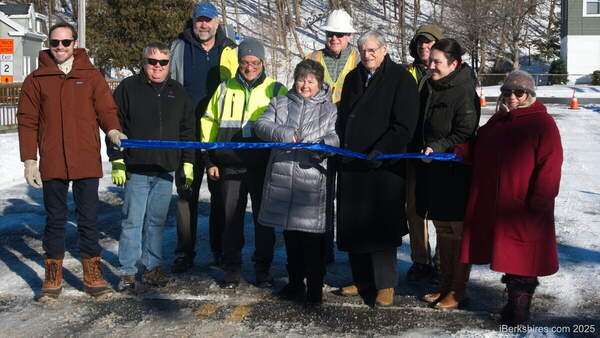Councilors Get Close-Up Look at Blight
 |
| View Slide Show |
City councilors touring several properties targeted for demolition were surprised at the sight of Franklin Perras perched on a ladder in the frigid winter air on Friday afternoon, painting the trimwork on the crumbling five-unit building.
"I just wanted it to look good for the city," said Perras as city officials and local media alighted from a van to take a closer look at 34-40 Arnold Place.
But while Perras was trying to spruce up the front, the building was rotting away in the back. As the tour wound around the exterior of the building, a huge hole could be seen at the roofline of the 2 1/2 story structure; a jack was holding up one section of the building.
"These sills are just rotted right out here," said Councilor Ron Boucher, chairman of the Public Safety Committee. "They've all got to be taken out ... You've got a major undertaking here, a very, very major undertaking."
Mayor John Barrett III is asking the City Council to declare Perras' property and three other buildings as public nuisances, giving the city the authority to order them demolished.
<L2>All three property owners have requested little more time to rehabilitate their structures but Barrett says time's run out - all four structures have been cited for a laundry list of problems, many dating back four years or more.
"I think we're beyond the cosmetic end of this, we need to know your plan, what you intend to do, how quickly you can do it," Building Inspector William Meranti told Perras on Friday.
The Public Safety Committee will make a recommendation to the City Council on what action to take on the properties. Boucher and fellow committee member Councilor Marie Harpin, Meranti, Health Inspector Manuel Serrano, Historical Commission member Justyna Carlson, Councilors Richard Alcombright, Lisa Blackmer, Gailanne Cariddi and President Alan L. Marden took the tour.
Perras, 70, appeared before the City Council on Tuesday, pleading his case. The retired military man hopes to rent the apartments as income for himself and his ailing brother. Perras said he lives at 124 Church St., which abuts the Arnold Place property, but the city has been contacting him through his address on Holmes Road in Hinsdale.
According to documents in Northern Berkshire Registry of Deeds, Perras purchased the Arnold Street property in 1998 for $17,900. He's been cited for numerous violations, including rotting porches, loose and missing slate roof tiles, crumbing sections of the brick foundation, rotten and open roof cornices, yard debris and improper excavations.
"It could be a beautiful building," said a neighbor who declined to be identified. But she was hoping the city would follow through with its demolition because it's not being maintained.
Perras has been told to come up with a concrete plan and a contractor who can repair the structure, although councilors expressed doubt of his assertions it could be rehabilitated by fall. On Friday, he said the back section could be done in "a week to 10 days."<R3>
"You notice he didn't invite us inside," said Cariddi as the van pulled away.
Perras, however, could get backing from the Historical Commission. The Arnold Place property is in an historic section of the city and surrounded by structures dating back to the 1850s. It's listed on the city's historical survey of structures.
"We're opposed to [demolishing] a house that's on the survey," said Carlson, adding that exceptions have been made.
The commission was given a list last year of 13 structures that fall under the mayor's initiative to wipe out blight in the city.
Carlson said the commission signed off on 11, including 7-9 Hoosac St., which is on the survey.
That house, near the college, is in high-visibility area, she said. "You have go out of your way to find Arnold Place."
Plus, the commission is taking into account a long-vacant lot next to the Arnold Place property. If the building is torn down it would open up a large empty area in an historic neighborhood. "We're afraid someone will build something that doesn't fit the rest of the street," said Carlson.
The commission has given its blessing to the razing of 34 Harrison Ave. and its neighbor, 26-28 Harrison Ave. The other houses on its list are 7-9 Hoosac St., 80 1/2 Prospect St., 344-346 Beaver St., 50 River St., 82 Brooklyn St., 223-225 and 229-231 East Main St., 181 Houghton St., 204 Bradley St. Extension and 111 River St. Along with Arnold Place, it has not signed off on the demolition of the River Street building.
<L4>Compared to Arnold Place, 34 Harrison is diminutive, a single-family home that's seen better days. It sits at the end of the hillside road off East Quincy Street.
Owner Arthur Boucher, no relation to the councilor, said his "Harrison Avenue nightmare" began in the 1990s - it took years to rid himself of the tenants, then years of constant vandalism.
The shingle-sided house had been boarded up for several years, although its hatchway was partially open and holes pockmarked the building. The building had been cited for having broken windows, rotting sills and missing siding and slate roofing tiles.
Boucher's sad tale was similar to Perras' - health issues had hampered his ability to spruce up the building. He'd tried to sell it, he told the councilors, but the prospective buyers kept falling through.
Given more time, he claimed he could get the house in shape for about $15,000, because he could do the work himself.
Last on the tour were the houses owned by tenement mogul Charles "Rusty" Ransford on East Main Street. The houses, at 223-225 and 229-231 East Main, are prominent features of lower East Main Street, and their backs can be seen along Willow Dell and the eastern entrance of the city.
Both houses sit on massive stone foundations about two stories high because they are perched over the edge of a nearly vertical hillside. Along the back, a series of porches are dipping dangerously along the vertical as well, as rotted floors and joists feel the pull of gravity. A white cabinet (or possibly a refrigerator) can barely be made out sitting on one of the top porches.<R5>
The four-, or five-, story houses have rotten sills, crumbling floors and numerous other issues. Ransford, who also asked for more time at Tuesday's City Council hearing, was not at the site. Because of the way the structures are situated on the site and the snow cover, councilors did not attempt to walk around the buildings.
The Public Safety Committee will meet Tuesday, March 4, at 3 p.m. in the City Council chambers to discuss what they observed on Friday's tour.















